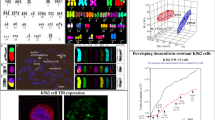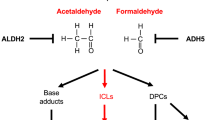Abstract
Background
Uranium mining and processing are an ancient occupation, recognized as being grueling and accountable for injury and disease. Uranium (U) is a radioactive heavy metal used in many industrial applications. It increases the micronuclei frequencies as well as chromosomal aberration and sister chromatid exchange in peripheral blood lymphocytes. Granzyme B and perforin are stored inside the leukocytes in secretory granules. These proteins are released outside the cells by a cell-to-cell contact under specific conditions for inducing apoptosis. So, this study investigated the potential health hazards with prominence on the biological effects of radiation exposure.
Methods
A cross-sectional analytic research was conducted on Egyptian male mining field workers. Leucocytes’ genotoxicity was evaluated using DNA fragmentation assay and comet assay. Furthermore, flow cytometric analysis of Granzyme B protein was done.
Results
A significant increase in dead cells after dual acridine orange/ethidium bromide (AO/EB) fluorescent staining in radiation-exposed groups was noticed compared to control groups. Moreover, a significant increase in the fragmented DNA was evident in exposed groups relative to the control one. Granzyme B protein levels showed a significant increase concerning control.
Conclusion
A wide variety of adverse human health risks are considered a potential risk to Egyptian uranium miners. For employers working in both mining and processing fields, the most common molecular shift highlighted was the leucocyte damage in blood samples. To preserve the health of all employees, health education and administration of effective hazard management procedures are necessary.


Similar content being viewed by others
Data availability
Data are available upon reasonable request.
References
Acharya MM, Lan ML, Kan VH, Patel NH, Giedzinski E, Tseng BP, Limoli CL (2010) Consequences of ionizing radiation-induced damage in human neural stem cells. Free Radic Biol Med 49(12):1846–1855. https://doi.org/10.1016/j.freeradbiomed.2010.08.021
Aljanabi SM, Martinez I (1997) Universal and rapid salt-extraction of high-quality genomic DNA for PCR-based techniques. Nucleic Acids Res 25(22):4692–4693. https://doi.org/10.1093/nar/25.22.4692
Arlett CF, Plowman PN, Rogers PB, Parris CN, Abbaszadeh F, Green MHL, McMillan TJ, Bush C, Foray N, Lehmann AR (2006) Clinical and cellular ionizing radiation sensitivity in a patient with xeroderma pigmentosum. Br J Radiol 79(942):510–517. https://doi.org/10.1259/bjr/83726649
Arzuaga X, Gehlhaus M, Strong J (2015) Modes of action associated with uranium induced adverse effects in bone function and development. Toxicol Lett 236(2):123–130. https://doi.org/10.1016/j.toxlet.2015.05.006
Azzam EI, Jay-Gerin J-P, Pain D (2012) Ionizing radiation-induced metabolic oxidative stress and prolonged cell injury. Cancer Lett 327(1-2):48–60. https://doi.org/10.1016/j.canlet.2011.12.012
Balentine J (2004) Cecil textbook of medicine, 22nd edition by Lee Goldman and Dennis Ausiello. Philadelphia, PA: Saunders (an imprint of Elsevier), 2004, 2,496 pages, $125.00 (hardcover and online CD-ROM version). Acad Emerg Med 11(9):997. https://doi.org/10.1016/s1069-6563(04)00774-2
Basset C, Averseng O, Ferron P-J, Richaud N, Hagège A, Pible O, Vidaud C (2013) Revision of the biodistribution of uranyl in serum: is fetuin-A the major protein target? Chem Res Toxicol 26(5):645–653. https://doi.org/10.1021/tx400048u
Bourgeois D, Burt-Pichat B, Le Goff X, Garrevoet J, Tack P, Falkenberg G, Van Hoorebeke L, Vincze L, Denecke MA, Meyer D, Vidaud C, Boivin G (2015) Micro-distribution of uranium in bone after contamination: new insight into its mechanism of accumulation into bone tissue. Anal Bioanal Chem 407(22):6619–6625. https://doi.org/10.1007/s00216-015-8835-7
Buzza MS, Bird PI (2006) Extracellular granzymes: current perspectives. Biol Chem 387(7):827–837. https://doi.org/10.1515/bc.2006.106
Cadet J, Douki T, Ravanat J-L (2010) Oxidatively generated base damage to cellular DNA. Free Radic Biol Med 49(1):9–21. https://doi.org/10.1016/j.freeradbiomed.2010.03.025
Carder AT (2018). Exposure and contamination. In Handling of Radiation Accident Patients: 35–62. CRC Press. https://doi.org/10.1201/9781351072816-2
Domingo JL (2001) Reproductive and developmental toxicity of natural and depleted uranium: a review. Reprod Toxicol 15(6):603–609. https://doi.org/10.1016/s0890-6238(01)00181-2
Donoghue AM (2004) Occupational health hazards in mining: an overview. Occup Med 54(5):283–289. https://doi.org/10.1093/occmed/kqh072
Doucey M-A, Legler DF, Faroudi M, Boucheron N, Baumgaertner P, Naeher D, Cebecauer M, Hudrisier D, Rüegg C, Palmer E, Valitutti S, Bron C, Luescher IF (2003) The β1 and β3 integrins promote T cell receptor-mediated cytotoxic T lymphocyte activation. J Biol Chem 278(29):26983–26991. https://doi.org/10.1074/jbc.m302709200
El-Garawani IM (2015) Ameliorative effect of Cymbopogon citratus extract on cisplatin-induced genotoxicity in human leukocytes. J Biosci Appl Res 1(6):304–310. https://doi.org/10.21608/jbaar.2015.106040
El-Garawani IM, Hassab El-Nabi SE (2016) Increased sensitivity of apoptosis detection using direct staining method and integration of acridine orange as an alternative safer fluorescent dye in agarose gel electrophoresis and micronucleus test. Can J Pure Appl Sci 10(2):3865–3871
El-Garawani I, Hassab S, Nabi E, El-Ghandour E (2017) The protective effect of (Foeniculum vulgare) oil on etoposide-induced genotoxicity on male albino rats. Eur J Pharm Med Res 4(7):180–194
El-Garawani I, Hassab El-Nabi S, El Kattan A, Sallam A, Elballat S, Abou-Ghanima S, El Azab IH, El-Seedi HR, Khalifa SAM, El-Shamy S (2021) The ameliorative role of Acacia senegal gum against the oxidative stress and genotoxicity induced by the radiographic contrast medium (ioxitalamate) in albino rats. Antioxidants 10(2):221. https://doi.org/10.3390/antiox10020221
El-Nabi Hassab SE, Elhassanee YA (2008) Detection of DNA damage, molecular apoptosis and production of home-made ladder by using simple techniques. Biotechnology(Faisalabad) 7(3):514–522. https://doi.org/10.3923/biotech.2008.514.522
Ermert M, Pantazis C, Duncker H-R, Grimminger F, Seeger W, Ermert L (2003) In situ localization of TNFα/β, TACE AND TNF receptors TNF-R1 and TNF-R2 in control and LPS-treated lung tissue. Cytokine 22(3–4):89–100. https://doi.org/10.1016/s1043-4666(03)00117-0
Gazin V, Kerdine S, Grillon G, Pallardy M, Raoul H (2004) Uranium induces TNFα secretion and MAPK activation in a rat alveolar macrophage cell line. Toxicol Appl Pharmacol 194(1):49–59. https://doi.org/10.1016/j.taap.2003.08.016
Gochfeld M (1997) Factors influencing susceptibility to metals. Environ Health Perspect 105(Suppl 4):817–822. https://doi.org/10.1289/ehp.97105s4817
Hao Y, Ren J, Liu C, Li H, Liu J, Yang Z, Li R, Su Y (2013a) Zinc protects human kidney cells from depleted uranium-induced apoptosis. Basic Clin Pharmacol Toxicol 114(3):271–280. https://doi.org/10.1111/bcpt.12167
Hao Y, Ren J, Liu J, Yang Z, Liu C, Li R, Su Y (2013b) Immunological changes of chronic oral exposure to depleted uranium in mice. Toxicology 309:81–90. https://doi.org/10.1016/j.tox.2013.04.013
Harrison JD (1991) The gastrointestinal absorption of the actinide elements. Sci Total Environ 100:43–60. https://doi.org/10.1016/0048-9697(91)90373-m
Hejase, Hussin (2018) Review of A review of the International Atomic Energy Agency (IAEA) International Standards for Tissue Banks. Publons. https://doi.org/10.14322/publons.r2254899
Heusel JW, Wesselschmidt RL, Shresta S, Russell JH, Ley TJ (1994) Cytotoxic lymphocytes require granzyme B for the rapid induction of DNA fragmentation and apoptosis in allogeneic target cells. Cell 76(6):977–987. https://doi.org/10.1016/0092-8674(94)90376-x
Kalinich JF, Ramakrishnan N, Villa V, McClain DE (2002) Depleted uranium–uranyl chloride induces apoptosis in mouse J774 macrophages. Toxicology 179(1–2):105–114. https://doi.org/10.1016/s0300-483x(02)00318-9
Kamiya K, Sasatani M (2012) Effects of radiation exposure on human body. Nihon Rinsho J 70:367–374
Leggett RW, Pellmar TC (2003) The biokinetics of uranium migrating from embedded DU fragments. J Environ Radioact 64(2–3):205–225. https://doi.org/10.1016/s0265-931x(02)00050-4
Liu K, Liu P, Liu R, Wu X (2015) Dual AO/EB staining to detect apoptosis in osteosarcoma cells compared with flow cytometry. Med Sci Monit Basic Res 21:15–20. https://doi.org/10.12659/MSMBR.893327
McHutchison JG, Dusheiko G, Shiffman ML, Rodriguez-Torres M, Sigal S, Bourliere M, Berg T, Gordon SC, Campbell FM, Theodore D, Blackman N, Jenkins J, Afdhal NH (2007) Eltrombopag for thrombocytopenia in patients with cirrhosis associated with hepatitis C. N Engl J Med 357(22):2227–2236. https://doi.org/10.1056/nejmoa073255
Meleo KA (2001). THYMOMA. In Veterinary Oncology Secrets :211–214. https://doi.org/10.1016/b978-1-56053-416-7.50039-7
Miller AC, Blakely WF, Livengood D, Whittaker T, Xu J, Ejnik JW, Hamilton MM, Parlette E, John TS, Gerstenberg HM, Hsu H (1998) Transformation of human osteoblast cells to the tumorigenic phenotype by depleted uranium-uranyl chloride. Environ Health Perspect 106(8):465–471. https://doi.org/10.1289/ehp.98106465
Miller AC, Stewart M, Brooks K, Shi L, Page N (2002) Depleted uranium-catalyzed oxidative DNA damage: absence of significant alpha particle decay. J Inorg Biochem 91(1):246–252. https://doi.org/10.1016/s0162-0134(02)00391-4
Miller AC, Brooks K, Stewart M, Anderson B, Shi L, McClain D, Page N (2003) Genomic instability in human osteoblast cells after exposure to depleted uranium: delayed lethality and micronuclei formation. J Environ Radioact 64(2–3):247–259. https://doi.org/10.1016/s0265-931x(02)00053-x
Murray RB (1977) The health hazards of not going nuclear, Petr Beckmann, Golem Press, 1976. Int J Energy Res 1(2):188. https://doi.org/10.1002/er.4440010210
Nichols WL (2012). Von Willebrand disease and hemorrhagic abnormalities of platelet and vascular function. In Goldman’s Cecil Medicine (pp. 1131–1136). Elsevier. https://doi.org/10.1016/b978-1-4377-1604-7.00176-7
Organization for Economic Co-operation and Development (OECD Publishing) (2014) Managing environmental and health impacts of uranium mining. Nuclear Dev. https://doi.org/10.1787/9789264216044-en
Petitot F, Lestaevel P, Tourlonias E, Mazzucco C, Jacquinot S, Dhieux B, Delissen O, Tournier BB, Gensdarmes F, Beaunier P, Dublineau I (2013) Inhalation of uranium nanoparticles: respiratory tract deposition and translocation to secondary target organs in rats. Toxicol Lett 217(3):217–225. https://doi.org/10.1016/j.toxlet.2012.12.022
Reisz JA, Bansal N, Qian J, Zhao W, Furdui CM (2014) Effects of ionizing radiation on biological molecules—mechanisms of damage and emerging methods of detection. Antioxid Redox Signal 21(2):260–292. https://doi.org/10.1089/ars.2013.5489
Saeed M, Sayed S, Amen A, Fahmi A, El. Garawani I. (2014) The possible protective effect of Coriandrum sativum seeds methanolic extract on hepato-renal toxicity induced by sodium arsenite in albino rats. J Appl Pharm Sci 4(12):44–51. https://doi.org/10.7324/JAPS.2014.41208
Saito Y, Kondo H, Hojo Y (2011) Granzyme B as a novel factor involved in cardiovascular diseases. J Cardiol 57(2):141–147. https://doi.org/10.1016/j.jjcc.2010.10.001
Sanders CL (1988) Toxicological aspects of energy production. Anal Chim Acta 207:380. https://doi.org/10.1016/s0003-2670(00)80819-3
Sanzari JK, Wan XS, Krigsfeld GS, King GL, Miller A, Mick R, Gridley DS, Wroe AJ, Rightnar S, Dolney D, Kennedy AR (2013) Effects of solar particle event proton radiation on parameters related to ferret emesis. Radiat Res 180(2):166–176. https://doi.org/10.1667/rr3173.1
Schins R (1999) Mechanisms and mediators in coal dust induced toxicity: a review. Ann Occup Hyg 43(1):7–33. https://doi.org/10.1016/s0003-4878(98)00069-6
Semenova Y, Pivina L, Zhunussov Y, Zhanaspayev M, Chirumbolo S, Muzdubayeva Z, others (2020) Radiation-related health hazards to uranium miners. Environ Sci Pollut Res 27(28):34808–34822. https://doi.org/10.1007/s11356-020-09590-7
Shaki F, Hosseini M-J, Ghazi-Khansari M, Pourahmad J (2012) Toxicity of depleted uranium on isolated rat kidney mitochondria. Biochim Biophys Acta Gen Subj 1820(12):1940–1950. https://doi.org/10.1016/j.bbagen.2012.08.015
Singh NP, McCoy MT, Tice RR, Schneider EL (1988) A simple technique for quantitation of low levels of DNA damage in individual cells. Exp Cell Res 175(1):184–191. https://doi.org/10.1016/0014-4827(88)90265-0
Tawn EJ, Whitehouse CA (2003) Stable chromosome aberration frequencies in men occupationally exposed to radiation. J Radiol Prot 23(3):269–278. https://doi.org/10.1088/0952-4746/23/3/304
Vacca A (2001) αvβ3 Integrin engagement modulates cell adhesion, proliferation, and protease secretion in human lymphoid tumor cells. Exp Hematol 29(8):993–1003. https://doi.org/10.1016/s0301-472x(01)00674-9
Vassalli P (1992) The pathophysiology of tumor necrosis factors. Annu Rev Immunol 10(1):411–452. https://doi.org/10.1146/annurev.iy.10.040192.002211
Vidaud C, Bourgeois D, Meyer D (2012) Bone as target organ for metals: the case of f-elements. Chem Res Toxicol 25(6):1161–1175. https://doi.org/10.1021/tx300064m
Wan B, Fleming JT, Schultz TW, Sayler GS (2006) In vitro immune toxicity of depleted uranium: effects on murine macrophages, CD4+ T cells, and gene expression profiles. Environ Health Perspect 114(1):85–91. https://doi.org/10.1289/ehp.8085
World Health Organization (WHO) (1996) Health consequences of the Chernobyl accident. Scientific Report. Editors: Souchkevitch GN, Tsyb AF; Published WHO Geneva. https://www.who.int/ionizing_radiation/chernobyl/WHO%20Report%20on%20Chernobyl%20Health%20Effects%20July%2006.pdf. Accessed 15 Dec 2020
Zhang X, Ding C, Liu H, Liu L, Zhao C (2011) Protective effects of ion-imprinted chitooligosaccharides as uranium-specific chelating agents against the cytotoxicity of depleted uranium in human kidney cells. Toxicology 286(1–3):75–84. https://doi.org/10.1016/j.tox.2011.05.011
Acknowledgements
The authors wish to acknowledge the volunteered participants for accepting to involve in this research.
Author information
Authors and Affiliations
Contributions
Islam El-Garawani performed the laboratory part of the study and helped in the revision and editing of the manuscript, Heba Khodary Allam and Yasser A Shehata formulated the study design and statistical analysis of the research, wrote the manuscript and revised the references, Khaldoun Fadel performed the clinical investigation for workers and Ahmed El Kattan performed the practical part of the research and conceived the idea.
Corresponding author
Ethics declarations
Ethics approval and consent to participate
The study was approved by the Medical Research Ethics Committee of the Faculty of Medicine, Menoufia University, Egypt. Written informed consent was signed by each participant before contribution.
Consent for publication
The authors transfer to the journal the publication rights and we warrant that this contribution is original, and we have full power to make this grant.
Competing interests
The authors declare no competing interests.
Additional information
Responsible Editor: Lotfi Aleya
Publisher’s note
Springer Nature remains neutral with regard to jurisdictional claims in published maps and institutional affiliations.
Rights and permissions
About this article
Cite this article
El-Garawani, I., Allam, H.K., Shehata, Y.A. et al. Genotoxicity linked to occupational exposure in uranium mine workers: Granzyme B and apoptotic changes. Environ Sci Pollut Res 28, 36793–36802 (2021). https://doi.org/10.1007/s11356-021-13323-9
Received:
Accepted:
Published:
Issue Date:
DOI: https://doi.org/10.1007/s11356-021-13323-9




